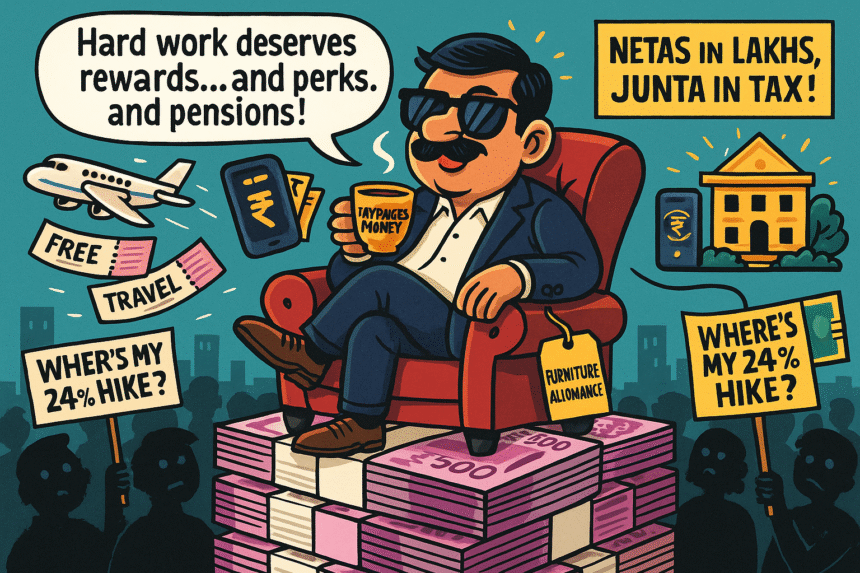Brace yourselves, taxpayers! If you thought your salary increment was impressive this year, wait until you hear about the big, fat paycheck boost our beloved Members of Parliament (MPs) are getting. The Centre has just approved a 24% salary hike for MPs, and it’s enough to make even top corporate executives blush.
Starting April 1, 2023 (no, it’s not an April Fool’s joke), our lawmakers will now earn a cool ₹1.24 lakh per month, up from ₹1 lakh. But wait, that’s just the base salary—the perks and allowances make it a party that even Ambani might RSVP to!
- What’s Changing? A Breakdown of the MP Payday Package
- A Day in the Life of an MP (Perks Edition)
- But What About the Ministers?
- Retired MPs Are Laughing Too (All the Way to the Bank)
- Public Reaction: Mixed Emotions (And Memes)
- How Are These Hikes Decided Anyway?
- The Other Side of the Story: Why the Raise Makes Sense (Sort of)
- The Taxpayer’s Dilemma: Should We Celebrate or Cry?
- Final Thoughts: “Netas in Lakhs, Junta in Tax”
Let’s dive into the numbers, benefits, and what this means for the neta-nagari, all served with a side of wit and wisdom.
What’s Changing? A Breakdown of the MP Payday Package
Here’s what the new “Netagiri Package 2.0” looks like:
| Category | Now | Earlier |
|---|---|---|
| Salary | ₹1.24 lakh | ₹1 lakh |
| Constituency Allowance | ₹87,000 | ₹70,000 |
| Office Expenses | ₹70,000 | ₹60,000 |
| Daily Allowance (per day) | ₹2,500 | ₹2,000 |
| MP’s Assured Monthly Income | ₹2.81 lakh | ₹2.3 lakh |
| Minister’s Monthly Income | ₹2.86 lakh | ₹2.3 lakh |
That’s right—MPs now have a monthly package that would make even a mid-level MNC manager jealous. And remember, this is excluding the generous perks they already enjoy!
A Day in the Life of an MP (Perks Edition)
Still wondering what makes a politician’s life so enviable? Here’s a quick peek at the cushy perks and VIP treatment that come with the badge:
- Daily Allowance: ₹2,500 per day to attend Parliament. Yes, they get paid to show up—something most employees only dream of!
- 34 Free Rail Tickets Annually – That’s nearly three per month, enough to criss-cross India like a vacation blogger.
- Free Air Travel: Why fly economy when the taxpayer can foot the bill?
- Free Electricity and Water: Because apparently, political heat and debates don’t count towards energy consumption.
- One-Time Furniture Allowance: MPs can now sit back (literally) on taxpayer-funded sofas.
- Smartphone Allowance, Domestic Help, and Office Staff Support – Because pushing bills and passing laws takes a village.
But What About the Ministers?
Ministers, while not entitled to the furniture allowance (poor them!), are given official accommodation and all the freebies MPs enjoy, including the air-travel bonanza. Their monthly assured income is now ₹2.86 lakh, with added “bonuses” for handling the nation’s administrative chaos.
They even enjoy government bungalows, so no rent or EMIs to worry about!
Retired MPs Are Laughing Too (All the Way to the Bank)
Even after hanging up their political boots, former MPs continue to enjoy the perks:
- Pension increased from ₹25,000 to ₹31,000.
- Additional pension of ₹2,500 for every extra year beyond five years in service.
That means someone who served three terms (15 years) will earn ₹41,000 per month, which is more than what some retired scientists or defense personnel receive. Irony? You decide.
Public Reaction: Mixed Emotions (And Memes)
While MPs were probably doing a little jig in Parliament over the raise, the public wasn’t entirely convinced:
- “Where’s my 24% hike?” cried every salaried middle-class citizen.
- “Can they please hike their accountability next?” joked a netizen.
- “When was the last time an MP’s performance review was done?” asked a particularly savage Reddit thread.
And let’s face it—MPs haven’t had a raise since 2018, so technically, this hike was long overdue. But in a country where inflation squeezes the common man daily, even a 4% DA hike makes headlines. A 24% boost for lawmakers? That’s like sprinkling salt on a budget burn.
How Are These Hikes Decided Anyway?
The raise is in accordance with:
- The Salaries, Allowances and Pensions of Members of Parliament Act.
- The Cost Inflation Index, a benchmark that tracks inflation year by year.
The revisions were recommended by the Joint Committee on Salaries and Allowances of Members of Parliament—which, we assume, includes MPs themselves. (Talk about deciding your own appraisal. Lucky folks!)
The Other Side of the Story: Why the Raise Makes Sense (Sort of)
To be fair, MPs have a tough job:
- Long hours, public scrutiny, and the pressure to deliver.
- Constant travel to and from their constituencies.
- Political meetings, media bites, and public engagement.
Their role is far more complex than what we see on TV. And if we want honest, corruption-free governance, maybe paying them well is a strategic move to eliminate the temptation of under-the-table deals.
But then again—isn’t performance-based pay a thing anymore?
The Taxpayer’s Dilemma: Should We Celebrate or Cry?
There’s no denying that MPs are public representatives and should be compensated fairly. But fair compensation should ideally be tied to:
- Attendance in Parliament (some don’t even show up!)
- Constituency Development
- Legislative Contributions
- Public Welfare and Accountability
Maybe the government should consider a “Pay-for-Performance” model, where lawmakers get a bonus if they introduce successful bills, attend all sessions, and steer real change.
Until then, we’re just paying a premium subscription for a channel we’re not sure we’re watching.
Final Thoughts: “Netas in Lakhs, Junta in Tax”
While this 24% hike may be well-deserved for hardworking MPs, it also raises a bigger question—how well are we managing the public exchequer? At a time when the country is still navigating post-pandemic recovery, rural distress, and rising living costs, the optics of a 24% hike aren’t exactly favorable.
So the next time you see your MP in your city, sipping chai and promising progress, don’t forget—you’re helping fund their furniture, flights, and filtered water.
At the very least, maybe they can show up to Parliament more often, pass that long-pending bill, and earn every rupee of their raised salary. Because in the end, a 24% hike in pay should come with a 100% hike in performance.
Over to you, Honourable Members!












